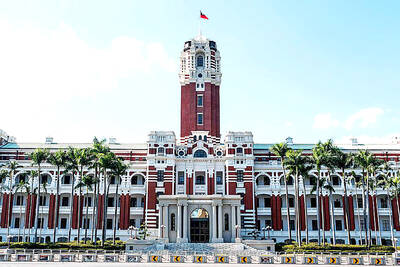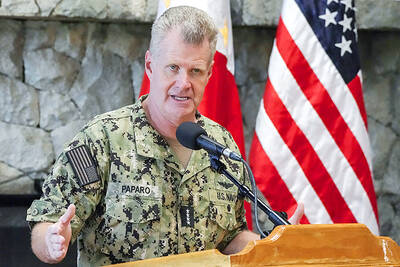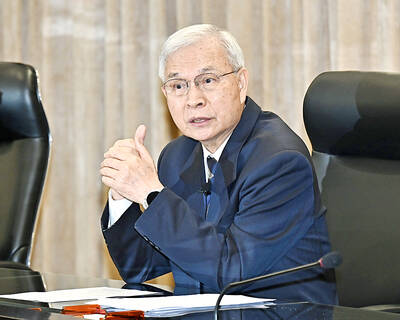South Korean President Lee Myung-bak yesterday urged North Korea to end its military provocations and make a “courageous change” as he laid out a long-term plan for reunification.
“It is about time Pyongyang looked straight at reality, made a courageous change and came up with a drastic decision,” Lee said.
The Koreas “need to overcome the current state of division and proceed with the goal of peaceful reunification,” he said in a speech to celebrate Korea’s liberation from Japanese colonial rule in 1945.
Lee also warned that South Korea would not tolerate any military provocations from North Korea.
“The North must never venture to carry out another provocation nor will we tolerate it if they do so again,” he said.
Cross-border tensions have been high since late May when South Korea and the US accused Pyongyang of attacking a South Korean warship.
The North, which vehemently denies the accusation, threatened retaliation after US and South Korean troops staged naval drills in a show of force.
Relations further worsened after North Korea last weekend seized a South Korean squid fishing boat operating off the east coast.
The North also fired an artillery barrage into waters in the Yellow Sea a week ago when South Korea wrapped up its biggest anti-submarine drill.
In his speech, Lee detailed a multi-step blueprint for reunification, starting with a “peace community” after the peninsula is cleared of nuclear weapons.
The next step is to dramatically develop the North’s economy and form an “economic community in which the two will work for economic integration,” he said.
Finally, the Koreas would be able “to remove the wall of different systems” and establish a community which will ensure “dignity, freedom and basic rights of all individuals,” he said.
REUNIFICATION TAX
“Through this process, we can ultimately bring about the peaceful unification of Korea,” he added.
North Korea didn’t immediately respond to Lee’s reunification proposal, but issued a warning that its military would be “merciless” in its retaliation against joint military exercises planned this week by South Korea and the US.
Lee also proposed a “reunification tax” to help fund the expected US$1 trillion bill when the two Koreas eventually rejoin.
There are no signs that North and South Korea are anywhere near close to reconciliation, with about 1 million soldiers facing off across the Cold War’s last great divide.
“Reunification will definitely come,” Lee said in the speech. “I believe that the time has come to start discussing realistic policies to prepare for that day such as a reunification tax.”
Lee said it was now time to start saving for the massive cost of reuniting with the North, whose economy has been driven close to ruin by central economic planning, heavy military expenditure and years of famine.
North Korea is an economic backwater, with annual GDP of about US$24 billon last year — less than 3 percent the size of the South’s economy.
By some estimates, it would cost more than US$1 trillion to absorb the North.
That could wreak havoc on South Korea’s economy, with a state-funded research agency saying it would raise the tax bill for South Koreans by the equivalent of 2 percentage points annually for 60 years.
Opinion polls, however, show more than 60 percent of South Koreans want unification, but they would prefer it happen later rather than sooner because of the cost.
Lee, who is halfway through his single five-year term, has advocated a hard-line approach toward Pyongyang unlike his liberal predecessors.
RESPONSE TO JAPAN
He has cut aid to a trickle and all but cut off investment in North Korea after Pyongyang conducted a second nuclear test and test-fired long range missiles last year.
In his biggest Cabinet reshuffle a week ago, Lee kept his foreign, defense and unification ministers in place, signaling little change in his policy.
Lee welcomed Japan’s efforts to improve ties, but said some issues had yet to be resolved.
“I have taken note of Japan’s effort, which represents one step forward,” he said.
Japanese Prime Minister Naoto Kan, who has sought stronger ties with South Korea, issued a fresh apology on Tuesday for colonial rule and promised to hand over precious Korean cultural artifacts.
Lee praised Kan for issuing an apology.
“However, there still remain issues that have to be resolved. The two countries are called upon to take concrete measures to forge a new relationship for another 100 years,” he said, without elaborating.
The two countries normalized relations in 1965, but Japan has often been criticized by its neighbors for glossing over wartime atrocities.
Also See: US, S Korea plan second exercise

The CIA has a message for Chinese government officials worried about their place in Chinese President Xi Jinping’s (習近平) government: Come work with us. The agency released two Mandarin-language videos on social media on Thursday inviting disgruntled officials to contact the CIA. The recruitment videos posted on YouTube and X racked up more than 5 million views combined in their first day. The outreach comes as CIA Director John Ratcliffe has vowed to boost the agency’s use of intelligence from human sources and its focus on China, which has recently targeted US officials with its own espionage operations. The videos are “aimed at

STEADFAST FRIEND: The bills encourage increased Taiwan-US engagement and address China’s distortion of UN Resolution 2758 to isolate Taiwan internationally The Presidential Office yesterday thanked the US House of Representatives for unanimously passing two Taiwan-related bills highlighting its solid support for Taiwan’s democracy and global participation, and for deepening bilateral relations. One of the bills, the Taiwan Assurance Implementation Act, requires the US Department of State to periodically review its guidelines for engagement with Taiwan, and report to the US Congress on the guidelines and plans to lift self-imposed limitations on US-Taiwan engagement. The other bill is the Taiwan International Solidarity Act, which clarifies that UN Resolution 2758 does not address the issue of the representation of Taiwan or its people in

US Indo-Pacific Commander Admiral Samuel Paparo on Friday expressed concern over the rate at which China is diversifying its military exercises, the Financial Times (FT) reported on Saturday. “The rates of change on the depth and breadth of their exercises is the one non-linear effect that I’ve seen in the last year that wakes me up at night or keeps me up at night,” Paparo was quoted by FT as saying while attending the annual Sedona Forum at the McCain Institute in Arizona. Paparo also expressed concern over the speed with which China was expanding its military. While the US

SHIFT: Taiwan’s better-than-expected first-quarter GDP and signs of weakness in the US have driven global capital back to emerging markets, the central bank head said The central bank yesterday blamed market speculation for the steep rise in the local currency, and urged exporters and financial institutions to stay calm and stop panic sell-offs to avoid hurting their own profitability. The nation’s top monetary policymaker said that it would step in, if necessary, to maintain order and stability in the foreign exchange market. The remarks came as the NT dollar yesterday closed up NT$0.919 to NT$30.145 against the US dollar in Taipei trading, after rising as high as NT$29.59 in intraday trading. The local currency has surged 5.85 percent against the greenback over the past two sessions, central